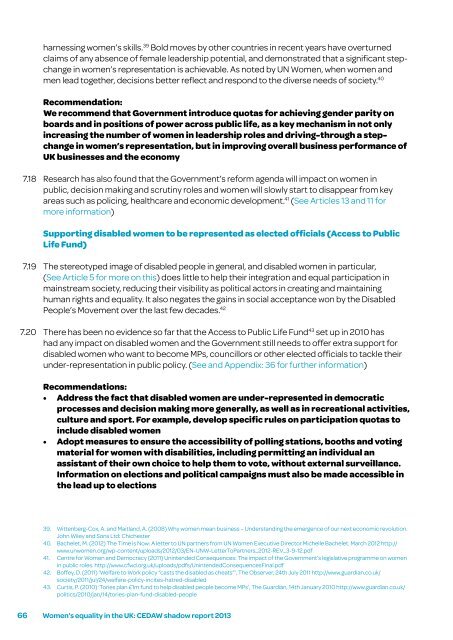Women’s equality in the UK – A health check
Women’s equality in the UK – A health check
Women’s equality in the UK – A health check
You also want an ePaper? Increase the reach of your titles
YUMPU automatically turns print PDFs into web optimized ePapers that Google loves.
7.18<br />
7.19<br />
7.20<br />
harness<strong>in</strong>g women’s skills. 39 Bold moves by o<strong>the</strong>r countries <strong>in</strong> recent years have overturned<br />
claims of any absence of female leadership potential, and demonstrated that a significant stepchange<br />
<strong>in</strong> women’s representation is achievable. As noted by UN Women, when women and<br />
men lead toge<strong>the</strong>r, decisions better reflect and respond to <strong>the</strong> diverse needs of society. 40<br />
Recommendation:<br />
We recommend that Government <strong>in</strong>troduce quotas for achiev<strong>in</strong>g gender parity on<br />
boards and <strong>in</strong> positions of power across public life, as a key mechanism <strong>in</strong> not only<br />
<strong>in</strong>creas<strong>in</strong>g <strong>the</strong> number of women <strong>in</strong> leadership roles and driv<strong>in</strong>g-through a stepchange<br />
<strong>in</strong> women’s representation, but <strong>in</strong> improv<strong>in</strong>g overall bus<strong>in</strong>ess performance of<br />
<strong>UK</strong> bus<strong>in</strong>esses and <strong>the</strong> economy<br />
Research has also found that <strong>the</strong> Government’s reform agenda will impact on women <strong>in</strong><br />
public, decision mak<strong>in</strong>g and scrut<strong>in</strong>y roles and women will slowly start to disappear from key<br />
areas such as polic<strong>in</strong>g, <strong>health</strong>care and economic development. 41 (See Articles 13 and 11 for<br />
more <strong>in</strong>formation)<br />
Support<strong>in</strong>g disabled women to be represented as elected officials (Access to Public<br />
Life Fund)<br />
The stereotyped image of disabled people <strong>in</strong> general, and disabled women <strong>in</strong> particular,<br />
(See Article 5 for more on this) does little to help <strong>the</strong>ir <strong>in</strong>tegration and equal participation <strong>in</strong><br />
ma<strong>in</strong>stream society, reduc<strong>in</strong>g <strong>the</strong>ir visibility as political actors <strong>in</strong> creat<strong>in</strong>g and ma<strong>in</strong>ta<strong>in</strong><strong>in</strong>g<br />
human rights and <strong>equality</strong>. It also negates <strong>the</strong> ga<strong>in</strong>s <strong>in</strong> social acceptance won by <strong>the</strong> Disabled<br />
People’s Movement over <strong>the</strong> last few decades. 42<br />
There has been no evidence so far that <strong>the</strong> Access to Public Life Fund 43 set up <strong>in</strong> 2010 has<br />
had any impact on disabled women and <strong>the</strong> Government still needs to offer extra support for<br />
disabled women who want to become MPs, councillors or o<strong>the</strong>r elected officials to tackle <strong>the</strong>ir<br />
under-representation <strong>in</strong> public policy. (See and Appendix: 36 for fur<strong>the</strong>r <strong>in</strong>formation)<br />
Recommendations:<br />
• Address <strong>the</strong> fact that disabled women are under-represented <strong>in</strong> democratic<br />
processes and decision mak<strong>in</strong>g more generally, as well as <strong>in</strong> recreational activities,<br />
culture and sport. For example, develop specific rules on participation quotas to<br />
<strong>in</strong>clude disabled women<br />
• Adopt measures to ensure <strong>the</strong> accessibility of poll<strong>in</strong>g stations, booths and vot<strong>in</strong>g<br />
material for women with disabilities, <strong>in</strong>clud<strong>in</strong>g permitt<strong>in</strong>g an <strong>in</strong>dividual an<br />
assistant of <strong>the</strong>ir own choice to help <strong>the</strong>m to vote, without external surveillance.<br />
Information on elections and political campaigns must also be made accessible <strong>in</strong><br />
<strong>the</strong> lead up to elections<br />
39. Wittenberg-Cox, A. and Maitland, A. (2008) Why women mean bus<strong>in</strong>ess <strong>–</strong> Understand<strong>in</strong>g <strong>the</strong> emergence of our next economic revolution.<br />
John Wiley and Sons Ltd: Chichester<br />
40. Bachelet, M. (2012) The Time is Now: A letter to UN partners from UN Women Executive Director Michelle Bachelet. March 2012 http://<br />
www.unwomen.org/wp-content/uploads/2012/03/EN-UNW-LetterToPartners_2012-REV_3-9-12.pdf<br />
41. Centre for Women and Democracy (2011) Un<strong>in</strong>tended Consequences: The impact of <strong>the</strong> Government’s legislative programme on women<br />
<strong>in</strong> public roles. http://www.cfwd.org.uk/uploads/pdfs/Un<strong>in</strong>tendedConsequencesF<strong>in</strong>al.pdf<br />
42. Boffey, D. (2011) ‘Welfare to Work policy “casts <strong>the</strong> disabled as cheats”’, The Observer, 24th July 2011 http://www.guardian.co.uk/<br />
society/2011/jul/24/welfare-policy-<strong>in</strong>cites-hatred-disabled<br />
43. Curtis, P. (2010) ‘Tories plan £1m fund to help disabled people become MPs’, The Guardian, 14th January 2010 http://www.guardian.co.uk/<br />
politics/2010/jan/14/tories-plan-fund-disabled-people<br />
66 <strong>Women’s</strong> <strong>equality</strong> <strong>in</strong> <strong>the</strong> <strong>UK</strong>: CEDAW shadow report 2013


